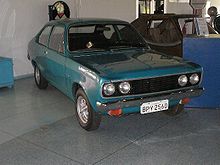Brazilian Miracle
This article includes a list of general references, but it remains largely unverified because it lacks sufficient corresponding inline citations. (February 2016) |
The Brazilian Miracle (Portuguese: milagre econômico brasileiro) was a period of exceptional economic growth in Brazil during the rule of the Brazilian military government. During this time the average annual GDP growth was close to 10%. The greatest economic growth was reached during the tenure of President Emílio Garrastazu Médici from 1969 to 1973.

Perception of the so-called Golden Age of Brazilian development was strengthened in 1970, when Brazil for the third time won the FIFA World Cup, and the official adoption of the slogan "Brasil, ame-o ou deixe-o" ("Brazil, love it or leave it") by the Brazilian military government.
Background[]
During the presidency of João Goulart, the economy was nearing a crisis, and the annual inflation rate reached 100%. After the 1964 coup d'état, the Brazilian military was more concerned with political control and left economic policy to a group of entrusted technocrats, led by Delfim Netto.[1]

Brazil became an urban society, with 67% of its people living in cities. That was caused by a population shift from the poorer countryside to the booming cities, with São Paulo growing faster than the others.[2]
Successes[]
The government became directly involved in the economy, as it invested heavily in new highways, bridges, and railroads. Steel mills, petrochemical factories, hydroelectric power plants, and nuclear reactors were built by the large state-owned companies Eletrobras and Petrobras. To reduce the dependency on imported oil, ethanol industry was heavily promoted.
By 1980, 57% of Brazil's exports were industrial goods, compared with 20% in 1968.[3]
In this period, the annual GDP growth rate jumped from 9.8% per year in 1968 to 14% in 1973 and inflation rose from 19.46% in 1968 to 34.55% in 1974.[4]
Problems[]
To fuel its economic growth, Brazil needed more and more imported oil. The early years of the Brazilian Miracle had sustainable growth and borrowing. However, the 1973 oil crisis made the military government increasingly borrow from international lenders, and the debt became unmanageable. By the end of the decade, Brazil had the largest debt in the world: about $US92 billion.[5]
Economic growth definitely ended with the 1979 energy crisis, which led to years of recession and hyperinflation.
References[]
- ^ Handler, Bruce (1975-06-08). "Plying High in Rio". The New York Times. ISSN 0362-4331. Retrieved 2019-04-18.
- ^ 1968–1980: the 'Brazilian Miracle'
- ^ Pattnayak, Satya R. (1996). Globalization, Urbanization, and the State: Selected Studies on Contemporary Latin America. University Press of America. ISBN 9780761803539.
- ^ Economia Brasileira Contemporânea. Giambiagi, Fabio,, Castro, Lavinia Barros de,, Hermann, Jennifer,, Villela, André ([3. ed.] ed.). Rio de Janeiro, Brasil. 2017-04-13. ISBN 9788535238556. OCLC 1049153964.
{{cite book}}: CS1 maint: others (link) - ^ Kilborn, Peter T.; Times, Special to The New York (1983-11-26). "Brazil's Economic 'Miracle' and Its Collapse". The New York Times. ISSN 0362-4331. Retrieved 2019-04-17.
- Economic history of Brazil
- 1960s economic history
- 1970s economic history
- Post–World War II economic booms